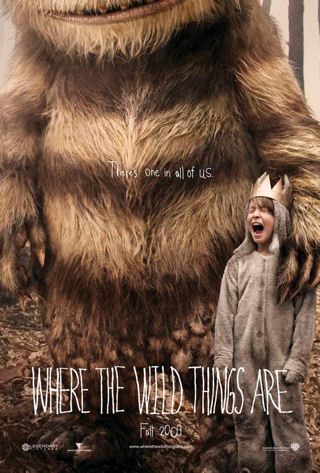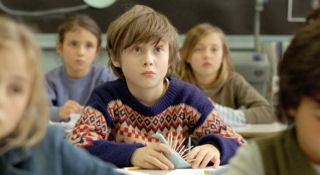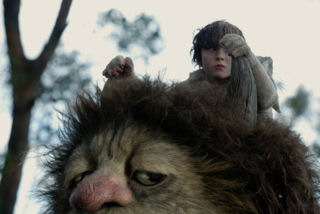|
Where
The Wild Things Are
It's amazing how prescient the combination
of Maurice Sendak, Dave Eggers and Spike Jonze could be.
In bringing the children's classic Where the Wild Things
Are to life on film, they've created a perfect allegory
for our current times.
The young boy Max (Max Records) clearly
stands for President Obama, who has ideas that he wants
to accomplish but is blocked at every turn by so-called
"adults" who make no effort to understand. The horned and
hairy Carol (James Gandolfini) is obviously Glenn Beck,
who loves his vision of his homeland so much that he wants
to tear it all down when things don't go his way, bullying
and crying when he fails…
Well, maybe it's not an allegory, but at
some point in watching the film of Sendak's iconic picture
book, you have to wonder "is there some deeper meaning
going on here?"
Another question you might ask is "why
don't I have the munchies?" because Where the Wild Things
Are may be the first film targeted squarely at mentally
gifted but frustrated first graders who really need to light
up once in a while just to take the edge off. It's a small
demographic, to be sure, but they're well served.
Jonze
has done justice to the book. If it's about the inarticulate
but wild range of emotions that childhood suffers, it's
all here. The script expands that out a bit, showing Max
struggling to stay connected with his older sister who's
clearly growing up and into a new peer group. An overly
zealous science teacher lectures Max and his fellow primary
graders about the eventual heat death of the solar system.
That's hard for a young kid to deal with, and it doesn't
help that Dad seems to have left the family and Mom (Catherine
Keener) works all the time.
Though Max might be a little over-indulged,
it's also hard not to empathize with the forces pushing
against him. Of course he doesn't have the words for them,
and he acts out inappropriately. All kids do. But when he
runs away from home and away from his mom's new beau (a
blink and you'll miss him Mark Ruffalo), naturally he has
to sail away on a boat that looks suspiciously like one
he's made out of wooden blocks in his room.
The journey takes him to a wild island
full of wild things, all of whom slowly reveal themselves
to just be a big band of children themselves. Yes, they're
a reflection of Max's own splintered emotions, and at first
it's sort of amusing as they delve into "the Wild Rumpus."
Some posture, some threaten, some throw
tantrums. And then they do it again. Just like Max, they
have a hard time putting a name to their feelings, to be
able to talk them out. Instead, they talk in impulsive threats
and a rage that for some reason they can't seem to feel
happy all the time.
And then they do it again. And again. To
break up the monotony, a couple take Max to look at cool
places on the island for heart to heart talks that don't
really open up because they just don't have the language
for it. The most articulate, naturally, are the females,
voiced by Catherine O'Hara and Lauren Ambrose.
In fact, Ambrose's KW seems to be the main
source of conflict, because she's willing to move outside
their little circle and find new friends. It's a common
childhood trauma, obviously reflecting Max's sense of losing
his sister, but it's just done so slowly.
The achievement of bringing Sendak's illustrations
to life, however, is amazing. They are life-like, and though
Jonze made some adjustments in design - the horned buffalo
is much darker, perhaps to better reflect his status as
the loneliest of them all - they still look like they could
have stepped right out of the book. And they step; this
is a combination of costuming and CG that works seamlessly
to make them believable.
In voicing the wild things, each actor
does a fine job, adult voices with child-like qualities
brought to the forefront. The live actors, too, handle each
scene with aplomb; there's just not much to them, nor much
explanation. Everything comes from Max's perspective, which
is both right and ultimately unknowable.
And that's frustrating. Where the Wild
Things Are will no doubt hit a certain cultural cache
as a noble art film, spawning midnight screenings and worthy
of study. But its glacial pace will certainly lose children,
because they've already instinctively gotten what it's about,
and the length of the original book is just about right
to hold their attention on that subject matter.
Kids have better things to do than sit
in the dark for a couple of hours watching this. They have
to go out and be wild themselves.
|









